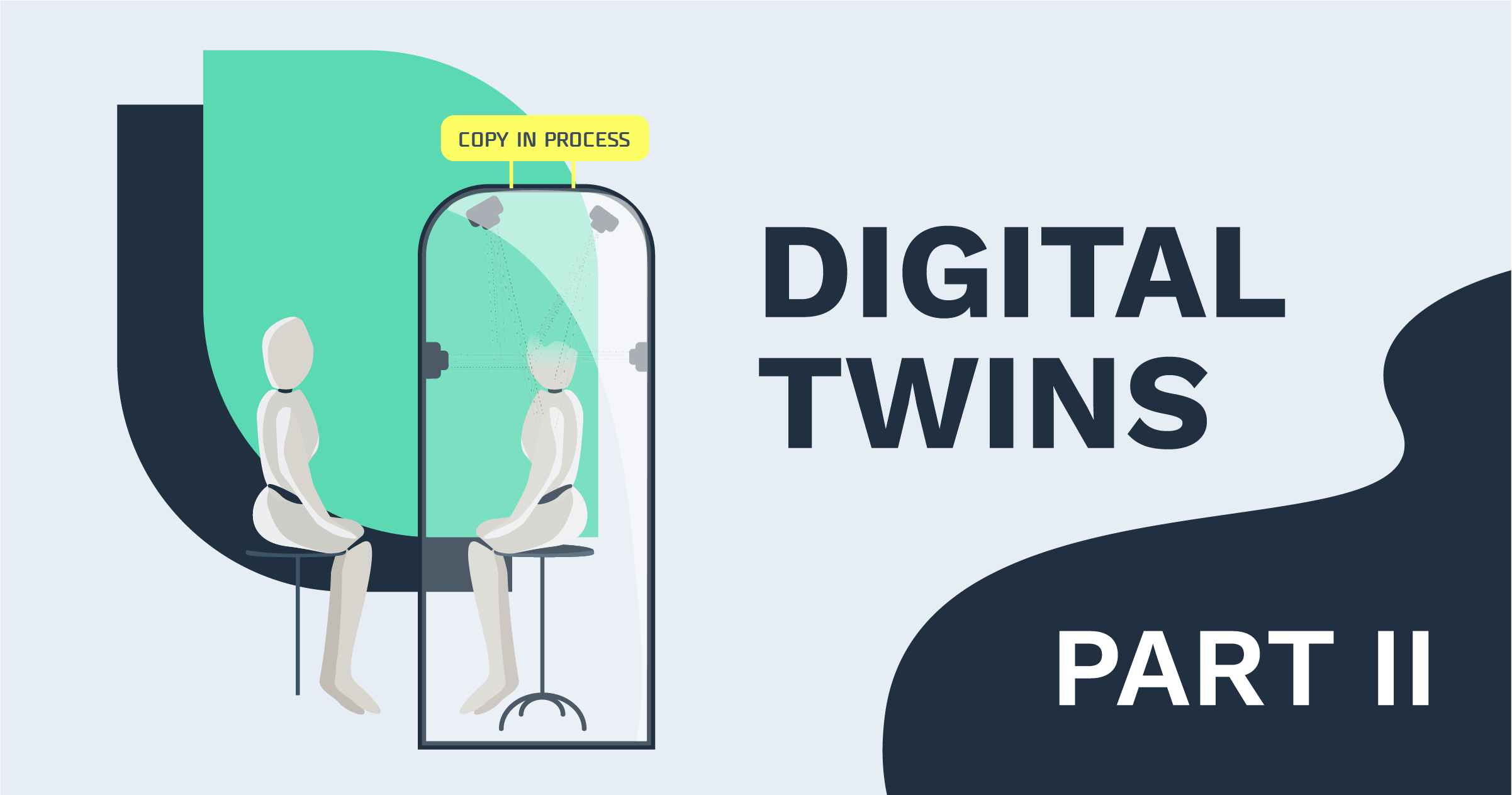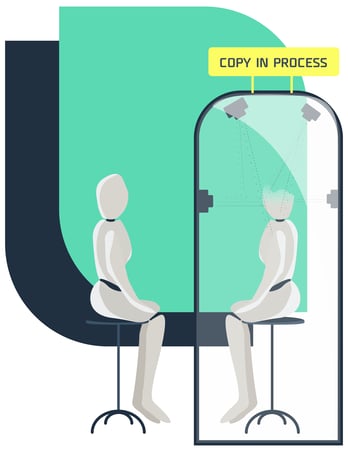Emerging Technologies in Retail: The Digital Twin

Are you looking to get ahead with emerging technologies? Part two of this three-part blog series explores what we should be considering about Digital Twins.
We chose three technologies to discuss: 5G communications, digital twins and blockchain. All three are rapidly evolving, and all three have demonstrable benefits for supply chain operations.
Digital twins are coming. A digital twin is a digital copy of a thing, process or being. Digital twins rely on sophisticated algorithms and artificial intelligence to parse information coming from sensors placed in and around the real object, along with historical data. They monitor and recreate the real-world item or process in real-time, creating a visual representation of what’s going on. Engineers can then change parameters in the simulation to see how the real thing will react, but without having to put it at risk.
While the term was coined in 2002,1 in fact, this concept has been around for a lot longer than that; with NASA famously using a ground-based model of the Apollo 11 capsule to figure out how to resolve critical issues in space back in 1970.2 In 2002, the McLaren Formula 1 team was using a digital twin simulation to predict performance, but it was around 2015 that the idea really started to become feasible with the advent of Internet of Things technology.3 Major manufacturers like GE have been using them since then to derive significant gains in manufacturing and maintenance.
In the supply chain, twins are relatively new kids on the block. Only in the past couple of years have digital twin solutions for logistics operations been made commercially available.
A digital twin is the logical, modern extension of the engineering prototype. Where engineers once modeled in clay, then moved to mechanical models and eventually to computer aided design, now they can create a digital copy of a real-world item or system or process and manipulate it to see how it reacts under different circumstances.
Magical Twin Powers
In general terms digital twins offer numerous benefits, including improved reliability, reduced risk, lower maintenance costs, more efficient production and faster return on investment.4 In an industrial example, using digital twins GE was able to improve a customer's reliability from 93 to 99.49 percent in less than two years, and cut reactive maintenance by 40 percent in just one year. A digital twin also saved a customer US$360 thousand by predicting a power outage.5
In logistics, analysts see tremendous potential for digital twins to drive efficiencies. Keeping tabs on distribution packaging, for example, could yield insight into how to make more sustainable packaging as well as helping track the millions of reusable containers in the transport system. Likewise, a digital twin of an entire shipment may give transportation planners the capacity to plan loads more efficiently and may turn out to be an incredibly effective tool for AI-enabled load matching services.
The trucks themselves offer a huge opportunity to streamline communications. Because they are now effectively rolling computers, they are sending data to various systems like maintenance, driver logs and fleet management but they send it multiple times in various formats. If each truck had a digital twin, which contained all the data, sent via a single channel, these other systems could access the twin and get the information they need.
“The traditional approach wastes effort and resources because the data is overlapping and redundant,” said W. Roy Schulte, Distinguished Vice President Analyst at Gartner. “Additionally, it’s very complex and expensive to establish a new channel for every new application that needs to access the data.”6
In the complex and fast-moving environment of a retail distribution centre, for example, a digital twin would enable operations managers to adjust for different scenarios without having to take the risk in real time. A new putaway process, for example, could be tested. Or new automated picking equipment could be specified and tried out to see how it would integrate with existing processes and equipment. The whole change can be tweaked and perfected, before the change is implemented in the real system.
All this is not fantasy or hype. Dematic has recently released a product that lets users explore a distribution centre environment before it is built to look at factors such as labour productivity, inventory movement and the effectiveness of material handling.7 The twin reduces risk by letting the DC's systems run in virtual reality before you commit to expensive capital outlays, making sure that it does what is expected and needed. According to Dematic, their system can be as specific as letting you know what happens if a barcode doesn't scan properly.
 In theory, an entire supply chain could be modeled this way, enabling adjustments from raw materials procurement right through to delivery to the final customer. In fact, the entire city-state of Singapore has been modeled into a digital twin by engineering firm Dassault Systèmes. It's being used to make decisions about infrastructure and how to manage possible emergencies like major fires or floods. The model is connected to traffic systems, climate data and transport vehicles.8
In theory, an entire supply chain could be modeled this way, enabling adjustments from raw materials procurement right through to delivery to the final customer. In fact, the entire city-state of Singapore has been modeled into a digital twin by engineering firm Dassault Systèmes. It's being used to make decisions about infrastructure and how to manage possible emergencies like major fires or floods. The model is connected to traffic systems, climate data and transport vehicles.8
Sounds a lot like a supply chain, doesn't it? Geographic information systems connected with autonomous vehicles will be able to deliver enormous amounts of data that can potentially fuel end-to-end supply chain twins. Add products to be tracked and you are pretty close to the elements that would be needed to replicate – and manage – an entire supply chain ecosystem from end to end.
Applications specific to retail operations are also coming. In addition to tracking inventory throughout the supply chain, twins technology is being used to model actual retail stores with the objective of guiding shoppers right to items on the shelf, as well as using the data on individual customers to create models that may be able to predict shopping behaviour.9
Double Trouble?
Digital twins are very compelling. They offer so much new opportunity thanks to the creation of digital sensors, the data they collect and the development of artificial intelligence to analyze and act on it all.
However, just because there are examples already in action and new models being developed as we speak, does not mean that digital twin technology will suddenly become the norm for assessing and streamlining operations, in spite of predictions. Back in 2018, Challenge Advisory predicted that by 2020 up to 60 percent of manufacturers would be monitoring product performance and quality with digital twins.10 A 2019 survey by Gartner put the brakes on a bit, suggesting the adoption rate would be more like 62 percent of the only 13 percent of organizations already using IoT technologies.11
A few hurdles will need to be cleared before we see the birth of a digital twin for every application. First is the challenge of integration. Most digital twin applications within the enterprise require the twins to achieve some level of integration with each other. According to Gartner, this remains a significant technical hurdle.
"The ability to integrate digital twins with each other will be a differentiating factor in the future, as physical assets and equipment evolve.”12
Further, for the grand, overarching, end-to-end supply chain model to come alive, numerous jurisdictional, regulatory and cooperative hurdles will need to be overcome. Just as we now struggle sometimes to communicate effectively between supply chain partners, this fragmentation of the logistics industry will also militate against effective twinning.
Data will need to be shared amongst numerous partners, with resulting concerns about security and proprietary and competitive information. It will take a lot of work for standards to be developed that all can agree on. And further down the road there will need to be agreement on how the massive amounts of data collected will be managed and owned.13
REFERENCES:
[1] "7 amazing examples of digital twin technology in practice", Bernard Marr, Forbes, April 23, 2019.
[2] "The history and creation of the digital twin concept", Carlos Miskinis, Challenge Advisory, March 2019.
[3] Digital twins in logistics, Klaus Dohrmann, Ben Gesing, Jonathan Ward, DHL, June 27, 2019.
[4] "Digital Twin", GE Digital, 2019.
[5] "Industrial digital twins: real products driving $1b in loss avoidance", Dimitri Volkmann, GE Digital blog, 2019.
[6] "How digital twins simplify the IoT", Sarah Hippold, Smarter with Gartner, January 23, 2019.
[7] "Dematic introduces modeling software to validate intralogistics system performance", Dematic media release, March 12, 2019.
[8] "Five things to know about digital twins", Emily Atkins, Inside Logistics, October 10, 2019.
[9] Digital twins in logistics, Klaus Dohrmann, Ben Gesing, Jonathan Ward, DHL, June 27, 2019.
[10] "The history and creation of the digital twin concept", Carlos Miskinis, Challenge Advisory, March 2019.
[11] "Gartner survey reveals digital twins are entering mainstream use", Gartner media release, February 20, 2019.
[12] "Gartner survey reveals digital twins are entering mainstream use", Gartner media release, February 20, 2019.
[13] Digital Twins: Beware of naïve faith in simplicity", Verdi Ogewell, engineering.com, January 4, 2018.

